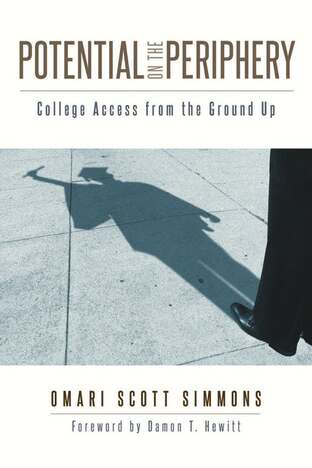Dr. Elwood Watson @bleachbred
Reviews
Potential on the Periphery: College Access from the Ground Up
Omari Scott Simmons @profosimmons
 @bleachbred
@bleachbred
In his new book, Potential on the Periphery: College Access From the Ground Up, Omari Scott Simmons, Howard L. Oleck Professor of Business Law Program at Wake Forest University, provides a unique look at higher education access that examines key distinctions that often exist between vulnerable students (e.g., low-income, underrepresented minority, historically disenfranchised, first generation, geographically isolated) and their more privileged counterparts when they attempt to transition from secondary school to college. It examines the complex challenges that impede higher education attainment for vulnerable students, highlighting the existence of two higher education systems: one for the vulnerable and the other for the privileged.
Higher education has always been an institution that has evolved over time often expanding access to a broader portion of the populace. No one who is astute to the dynamics in higher education can deny that higher education has underwent a dramatic change over that past 25 years. These transformations have manifested themselves in form of:
While some of the aforementioned issues affect students from all walks of life, a number of them acutely impact vulnerable students, particularly those from lower income backgrounds. This is largely due to the fact that these students are less likely to receive quality college selection counseling and more likely to be affected by decreases in state funding, targeted by for profit institutions, and sometime struggle to retain the grades and financial wherewithal to remain in school. In short, they face a plethora of minefields that can derail these highly talented students as they pursue a bachelor degree and advanced degrees.
Simmons makes the compelling case that many talented students from vulnerable backgrounds flounder between secondary school and college in the absence of attentive and competent intervention from advisors and mentors who are aware of their needs and or potential. As a result of years of witnessing and studying such patterns as co-founder and director of the Simmons Memorial Foundation (SMF), a grassroots organization that assists vulnerable students in the highly competitive college admissions process to garner admission to selective and resource-rich institutions. Moreover, he is able to synthesize for a broader audience the larger realm of existing academic practices, related theories, and public policy. He skillfully and successfully demonstrates the frequent reasons that derail vulnerable student academic success among them being a deficient amount of information about college options, financial pressures, limited opportunities for social capital acquisition, and doubts concerning their ability to thrive in elite educational environments among other challenges. This is discussed in more detail in chapters two and four.
Throughout the book, particularly in chapter three, the author provides some fantastic perspectives gleaned from student interviews. These perspectives, from both Delaware and North Carolina-based SMF students, illustrate the complex challenges vulnerable students navigate when pursuing higher education. For anyone who has a speck of human compassion, you will cheer at the inspiring success stories of SMF students, who demonstrate formidable strength as they tower against considerable adversity, and empathize with them along their journey.
In the final chapter of the book, Simmons provides a number of innovative reforms such as: enhancing the self-standing college counseling function in public high schools nationwide to help the most needy students; increasing federal, state, and institutional need-based aid; establishing partnerships between college access organizations, high schools, and selective colleges; exposing vulnerable students to mentors and career opportunities; and creating a national online course for college admissions.
One particularly strong feature of Potential at the Periphery, is that Simmons is adept at assembling comprehensive and often tedious research into lucid and accessible reading. The book is one of a number that promote the standard (largely true) argument that there are more than a few diamonds in the rough who, if given appropriate attention and resources, can flourish and excel. Beyond identifying challenges, it offers provocative and intelligent reforms that deserve serious thought and consideration, if not immediate implementation.
Potential on the Periphery: College Access from the Ground Up, provides an impressive playbook for modern policy and practice surrounding college access that is both traditional and avant-garde in nature. It is a deeply informative, lucidly written book that is a valuable and needed resource complimenting a growing collection of books that discuss college access and its connection to the broader issue of inequality.
Elwood Watson,Ph.D.
Higher education has always been an institution that has evolved over time often expanding access to a broader portion of the populace. No one who is astute to the dynamics in higher education can deny that higher education has underwent a dramatic change over that past 25 years. These transformations have manifested themselves in form of:
- changing student demographics;
- ongoing innovation and technological advances;
- decreased state funding;
- competition from for profit colleges;
- retention issues;
- continual increase in cost; and
- other related issues.
While some of the aforementioned issues affect students from all walks of life, a number of them acutely impact vulnerable students, particularly those from lower income backgrounds. This is largely due to the fact that these students are less likely to receive quality college selection counseling and more likely to be affected by decreases in state funding, targeted by for profit institutions, and sometime struggle to retain the grades and financial wherewithal to remain in school. In short, they face a plethora of minefields that can derail these highly talented students as they pursue a bachelor degree and advanced degrees.
Simmons makes the compelling case that many talented students from vulnerable backgrounds flounder between secondary school and college in the absence of attentive and competent intervention from advisors and mentors who are aware of their needs and or potential. As a result of years of witnessing and studying such patterns as co-founder and director of the Simmons Memorial Foundation (SMF), a grassroots organization that assists vulnerable students in the highly competitive college admissions process to garner admission to selective and resource-rich institutions. Moreover, he is able to synthesize for a broader audience the larger realm of existing academic practices, related theories, and public policy. He skillfully and successfully demonstrates the frequent reasons that derail vulnerable student academic success among them being a deficient amount of information about college options, financial pressures, limited opportunities for social capital acquisition, and doubts concerning their ability to thrive in elite educational environments among other challenges. This is discussed in more detail in chapters two and four.
Throughout the book, particularly in chapter three, the author provides some fantastic perspectives gleaned from student interviews. These perspectives, from both Delaware and North Carolina-based SMF students, illustrate the complex challenges vulnerable students navigate when pursuing higher education. For anyone who has a speck of human compassion, you will cheer at the inspiring success stories of SMF students, who demonstrate formidable strength as they tower against considerable adversity, and empathize with them along their journey.
In the final chapter of the book, Simmons provides a number of innovative reforms such as: enhancing the self-standing college counseling function in public high schools nationwide to help the most needy students; increasing federal, state, and institutional need-based aid; establishing partnerships between college access organizations, high schools, and selective colleges; exposing vulnerable students to mentors and career opportunities; and creating a national online course for college admissions.
One particularly strong feature of Potential at the Periphery, is that Simmons is adept at assembling comprehensive and often tedious research into lucid and accessible reading. The book is one of a number that promote the standard (largely true) argument that there are more than a few diamonds in the rough who, if given appropriate attention and resources, can flourish and excel. Beyond identifying challenges, it offers provocative and intelligent reforms that deserve serious thought and consideration, if not immediate implementation.
Potential on the Periphery: College Access from the Ground Up, provides an impressive playbook for modern policy and practice surrounding college access that is both traditional and avant-garde in nature. It is a deeply informative, lucidly written book that is a valuable and needed resource complimenting a growing collection of books that discuss college access and its connection to the broader issue of inequality.
Elwood Watson,Ph.D.

